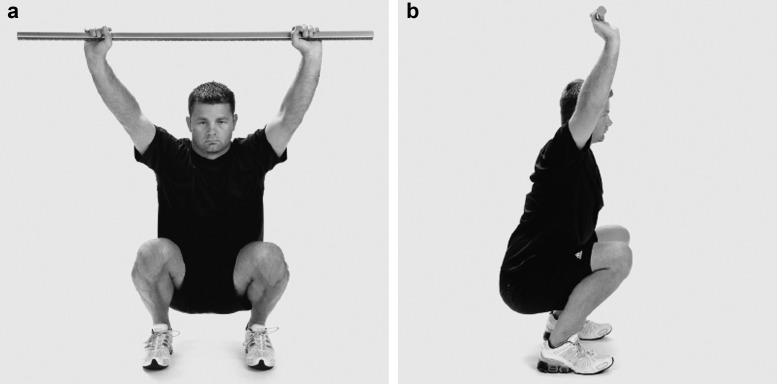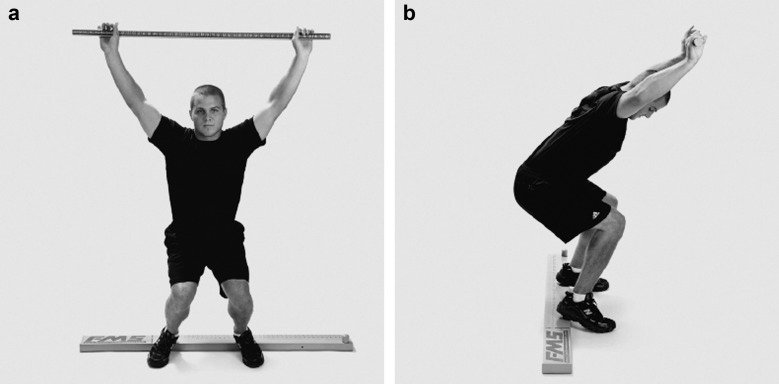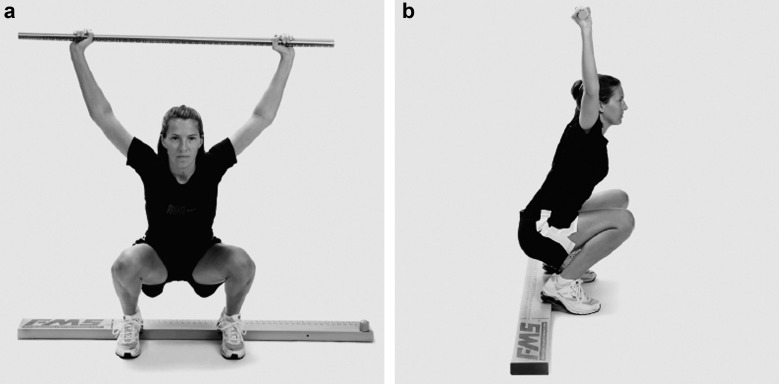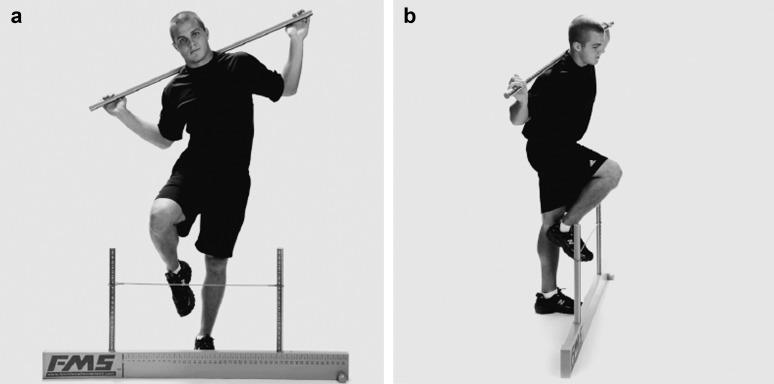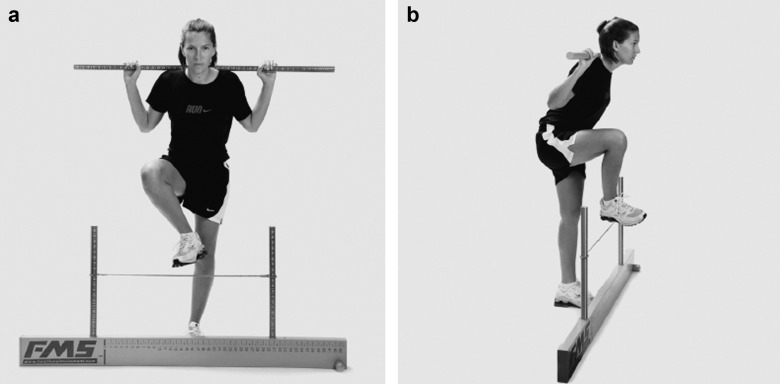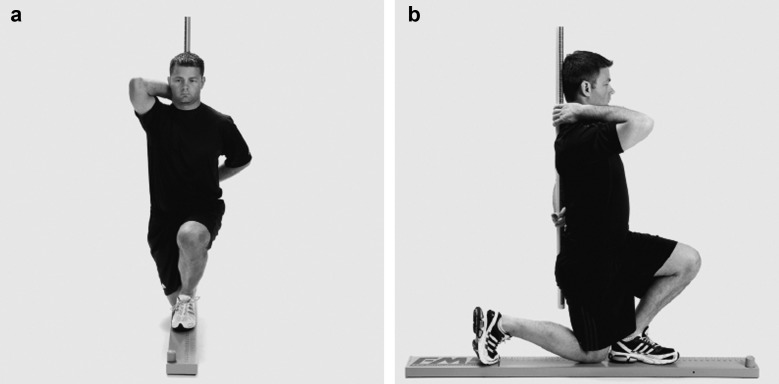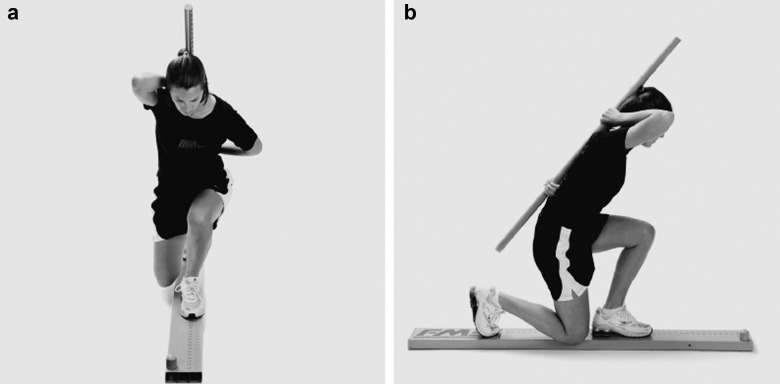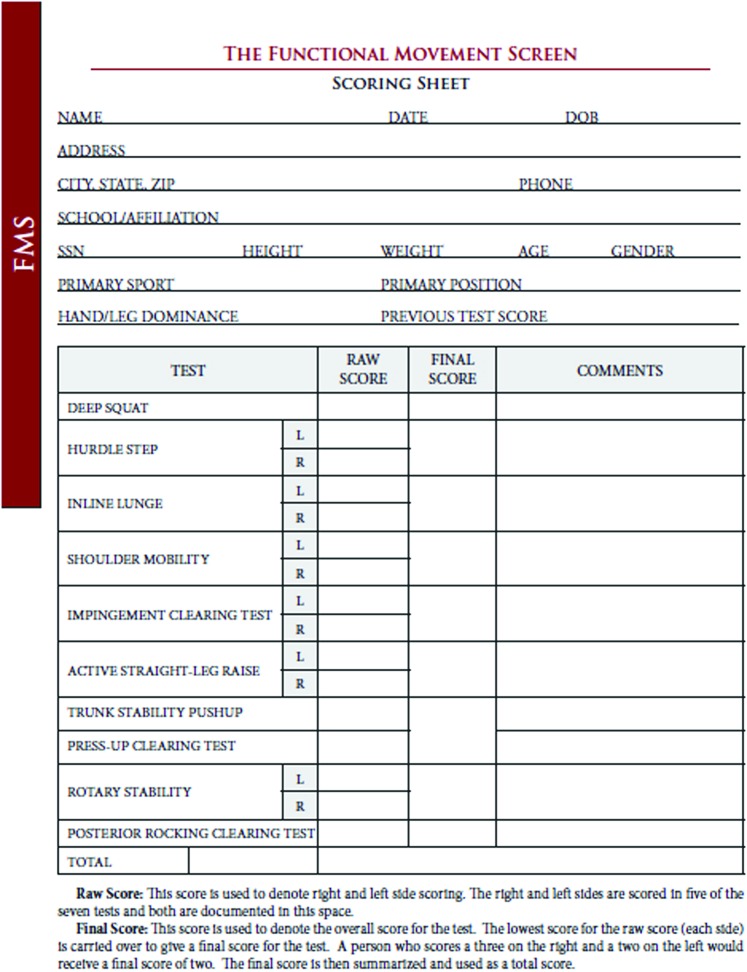ABSTRACT
To prepare an athlete for the wide variety of activities needed to participate in or return to their sport, the analysis of fundamental movements should be incorporated into screening in order to determine who possesses, or lacks, the ability to perform certain essential movements. In a series of two articles, the background and rationale for the analysis of fundamental movement will be provided. The Functional Movement Screen (FMS™) will be described, and any evidence related to its use will be presented. Three of the seven fundamental movement patterns that comprise the FMS™ are described in detail in Part I: the Deep Squat, Hurdle Step, and In‐Line Lunge. Part II of this series which will be provided in the August issue of IJSPT, will provide a detailed description of the four additional patterns that complement those presented in Part I (to complete the seven total fundamental movements): Shoulder Mobility, the Active Straight Leg Raise, the Trunk Stability Push‐up, and Rotary Stability, as well as a discussion about the utility of functional movement screening, and the future of functional movement.
The intent of this two part series is to present the concepts associated with screening of fundamental movements, whether it is the FMS™ system or a different system devised by another clinician. Such a functional assessment should be incorporated into pre‐participation screening and return to sport testing in order to determine whether the athlete has the essential movements needed to participate in sports activities at a level of minimum competency.
Level of Evidence:
5
Keywords: Function, movement screening, performance testing
INTRODUCTION
Over the last 20 years the profession of sports rehabilitation has undergone a trend away from traditional, isolated assessment and strengthening toward an integrated, functional, movement‐based approach, incorporating the principles of proprioceptive neuromuscular facilitation (PNF), muscle synergy, and motor learning.1,2 In fact, the American Physical Therapy Association House of Delegates adopted the following vision statement for the profession of physical therapy in 2013: “Transforming society by optimizing movement to improve the human experience”.3, p.18 Attention to optimal movement in patients and clients is important for all physical therapists, and especially for those who treat athletes.
Function is a common term in current physical therapist practice, and what is defined as functional varies greatly between patients and clients. Being functional is of utmost importance to excellent and comprehensive rehabilitation. However, it is difficult to develop and refer to protocols or movement approaches as “functional” when a functional evaluation standard does not exist. Often, rehabilitation professionals in sports settings are far too anxious to perform specific isolated, objective testing for joints and muscles. Likewise, these clinicians often perform sports performance and specific skill assessments without first examining functional movement. It is important to inspect and understand common fundamental aspects of human movement realizing that similar movements occur throughout many athletic activities. The rehabilitation professional must realize that in order to prepare individuals for a wide variety of activities, screening of fundamental movements is imperative.
Today's individuals are working harder to become stronger and healthier, by working to improve their flexibility, strength, endurance, and power. It is the belief of the authors that many athletes and individuals are performing high‐level activities despite being inefficient in their fundamental movements; thus, without knowing it, these individuals are attempting to add fitness to dysfunction. Many individuals train around a pre‐existing problem or simply do not train their weaknesses during strength and conditioning (fitness) programs. In today's evolving training and rehabilitation market, athletes and medical professionals have access to a huge arsenal of equipment and workout programs; however, the best equipment and programs cannot improve fitness and health if fundamental weaknesses are not exposed. The goal is to individualize each workout program based on the person's weak link. This weak link is a physical or functional limitation. In order to isolate the weak link, the body's fundamental movement patterns should be considered. Most people do not begin strength and conditioning or rehabilitative programs by determining if they have adequate movement patterns. Thus, the authors suggest that screening an individual's fundamental movements prior to beginning a rehabilitative or strength and conditioning program is important. By looking at the movement patterns and not just one area, a weak link can be identified. This will enable the medical professional to focus on that area. If this weak link is not identified, the body will compensate, causing inefficient movements. It is this type of inefficiency that can cause a decrease in performance and an increase in injuries.
Prescribed strength and conditioning programs often work to improve agility, power, speed, and strength without consideration of movement competency or efficiency of underlying functional movement. An example would be a person who has an above average score on the number of sit‐ups performed during a test but is performing very inefficiently by compensating and initiating the movement with the upper body and cervical spine as compared to the trunk. Compare this person to an individual who scores above average on the number of sit‐ups, but is performing very efficiently and does not utilize compensatory movements to achieve the sit‐up. These two individuals would each be deemed “above average” without noting their individual movement inefficiencies. The question arises: If major deficiencies are noted in their functional movement patterns, then should their performance be judged as equal? These two individuals would likely have significant differences in functional mobility and stability; however, without assessing their functional mobility and stability, it is inappropriate to assume differences.
In an additional example, at the conclusion of “formal rehabilitation”, performance and sport‐specific tests are conducted to attempt to determine the readiness of the athlete to return to sport. This systematic process does not seem to provide enough baseline information when assessing an individual's preparedness for participation in sporting activities. Commonly, the pre‐return to sport rehabilitation examination includes only information that will exclude an individual from participating in certain activities. The perception of many past researchers is that no set standards exist for determining who is physically prepared to participate in activities.4‐8
Commonly recommended performance tests could include sit‐ups, push‐ups, endurance runs, sprints, jumps, hops, and other power and agility activities.9 In many athletic and occupational settings, these performance activities are selected and refined for the individual and are specific to the tasks needed for their areas of performance. Most would agree: the main goals in performing pre‐participation, performance, or return to sport screening are to decrease the potential for injury, prevent re‐injury, enhance performance, and ultimately improve quality of life.6,8,10 Currently the research is inconsistent on whether the pre‐participation or performance screenings and standardized fitness measures have the ability to achieve this main goal.6,7 A reason for the lack of predictive value of screenings is that the standardized screenings do not provide individualized, fundamental analysis of an individual's movements.
The intended purpose of movement screening opens the doors for many improvements in the way individuals train and rehabilitate in several ways, including but not limited to:
Identifying individuals at risk, who are attempting to maintain or increase activity level.
Assisting in program design by systematically using corrective exercise to normalize or improve fundamental movement patterns.
Providing a systematic tool to monitor progress and movement pattern development in the presence of changing injury status or fitness levels.
Creating a functional movement baseline, which will allow rating and ranking movement for statistical observation.
The authors of this clinical commentary suggest that screening and analysis of fundamental movement should be incorporated into pre‐season screening and return to sport testing in order to determine who possesses, or lacks, the ability to perform certain essential movements. Therefore, the purpose of this clinical commentary (the first of a two‐part series) is to describe the first three tests of the FMS™ and offer suggestions on the utility and reliability of functional movement screening as a part of pre‐participation and return to sport testing.
THE FUNCTIONAL MOVEMENT SCREEN™
The Functional Movement Screen (FMS)™ is a screening system that attempts allow the professional to assess the fundamental movement patterns of an individual.2,11,12,13 This screening system fills the void between the pre‐participation/pre‐placement screenings and performance tests by evaluating individuals in a dynamic and functional capacity. Such a screening system may also provide a crucial tool to assist in determining readiness to return to sport at the completion of rehabilitation after injury or surgery. A screening tool such as this may offer a different approach to injury prevention and performance predictability. When used as a part of a comprehensive assessment, the FMS™ can lead to individualized, specific, functional recommendations for physical fitness protocols in athletic and active population groups.
The FMS™ is comprised of seven fundamental movement patterns (tests) that require a balance of mobility and stability (including neuromuscular/motor control). These fundamental movement patterns are designed to provide observable performance of basic locomotor, manipulative, and stabilizing movements. The tests place the individual in extreme positions where weaknesses and imbalance become noticeable if appropriate stability and mobility is not utilized. It has been observed that may individuals who perform at very high levels during activities may be unable to perform these simple movements2 and that these individuals should be considered to be utilizing compensatory movement patterns during their activities; sacrificing efficient movements for inefficient ones in order to perform at high levels. When poor or inefficient movement patterns are reinforced, this could lead to poor biomechanics and ultimately increase the potential for micro‐ or macro‐traumatic injury.
The FMS™ test movements were created for use in screening fundamental movements, based on proprioceptive and kinesthetic awareness principles. Each test is a specific movement, which requires appropriate function of the body's kinetic linking system. The kinetic link model, used to analyze movement, depicts the body as a linked system of interdependent segments. Body segments often work in a proximal‐to‐distal sequence, in order to impart a desired action at the distal segment.14 An important aspect of this system is the body's proprioceptive abilities. Proprioception can be defined as a specialized variation of the sensory modality of touch that encompasses the sensation of joint movement and joint position sense.15 Proprioceptors in each segment of the kinetic chain must function properly in order for efficient movement patterns to occur. Proproioceptive input provides the basis for all motor control (motor output) and human movement.
The term “regional interdependence” is used to describe the relationship between regions of the body and how dysfunction in one region may contribute to dysfunction in another region.16,17 In fact, it is becoming accepted that what may appear to be an isolated injury or dysfunction may have far reaching effects in regions away from the injury site.18‐23 Nadler et al22 demonstrated that rehabilitation after injury should not be isolated to the injured region, rather, it should address the athlete as a whole in order to return the athlete to the highest level of function.24
During growth and development, and individual's proprioceptors are developed through predictable reflexive movements in order to perform basic motor tasks. This development occurs from proximal to distal, the infant learning to first stabilize the proximal joints in the spine and torso and eventually the distal joints of the extremities. This progression occurs due to maturation and learning. The infant learns fundamental movements by responding to a variety of stimuli, through the process of developmental motor learning. As growth and development progresses, the proximal to distal process becomes operational and has a tendency to reverse itself. The process of movement regression slowly evolves in a distal to proximal direction.25 This regression occurs as individuals gravitate toward specific skills and movements thorough habit, lifestyle, and training.
Application Examples
Firefighters initially train and learn the skills associated with their trade through controlled, voluntary movements. Then, through repetition, their movements become stored centrally as motor programs, using the complex process of motor learning. It is very important to note that motor learning is not about specific body parts, joints, or the use of isolated muscles. Rather, it is about synergy, balance, symmetry, and skill during WHOLE movement patterns.2 Over time, each motor program requires fewer cognitive commands leading to improved subconscious performance of the task. This subconscious performance involves the highest levels of central nervous system function, known as cognitive programming.15 In this example, problems would arise when the movements and training being “learned” are performed incorrectly, inefficiently, or asymmetrically.
A sport‐specific example is a football lineman entering preseason practice who does not have the requisite balance of mobility or stability to perform a specific skill such as blocking. The athlete may perform the skill utilizing compensatory movement patterns in order to overcome the stability or mobility inefficiencies. The compensatory movement pattern will then be reinforced throughout the training process. In such an example, the individual creates a poor movement pattern that will be subconsciously utilized whenever the task is performed. Programmed altered movement patterns have the potential to lead to further mobility and stability imbalances, which have previously been identified as risk factors for injury.26‐28
An alternative explanation for development of poor movement patterns is the presence of previous injuries. Individuals who have suffered an injury may have a decrease in proprioceptive input, if untreated or treated inappropriately.15,29 A disruption in proprioceptive performance will have a negative effect on the kinetic linking system. The result will be altered mobility, stability, and asymmetric influences, eventually leading to compensatory movement patterns. This may be a reason why prior injuries have been determined to be one of the more significant risk factors in predisposing individuals to repeat injuries.29‐31
Determining which risk factor has a larger influence on injury, previous injuries or stability/mobility imbalances, is difficult. In either case, both can lead to deficiencies in functional performance. Cholewicki et al32 demonstrated that limitation in stability of the spine led to muscular compensation, fatigue, and pain. Gardner‐Morse et al33 determined that spinal instabilities result in degenerative changes due to the muscle activation strategies, which may be disrupted due to previous injury, stiffness, or fatigue. In addition, Battie et al34 demonstrated that individuals with previous low back pain performed timed shuttle runs at a significantly lower pace than individuals who did not have previous low back pain.
Therefore, an important factor in prevention of injuries and improving performance is to quickly identify deficits in symmetry, mobility, and stability because of their influences on creating altered motor programs throughout the kinetic chain. The complexity of the kinetic linking system makes the evaluation of weaknesses using conventional, static methods difficult. For that reason, utilizing functional screening tests that incorporate the entire kinetic linking system is important to identify and describe deficiencies in the system.5,28,34 The FMS™ was designed to identify individuals who have developed compensatory movement patterns within the kinetic chain.2 This identification is accomplished by screening for right and left side imbalances as well as observing mobility and stability dysfunction. The seven movements in the FMS™ attempt to challenge the body's ability to facilitate movement through the proximal‐distal sequence. This course of movement in the kinetic chain allows movement efficiently, much like the correct movement patterns that were initially formed during growth and development. However, due to a weakness or dysfunction in the kinetic linking system, a poor movement pattern may have resulted. Once an inefficient movement pattern has been isolated by the FMS™, functional strategies can be instituted in order to attempt to avoid problems associated with imbalances and movement compensations.2
Scoring the Functional Movement Screen™
The scoring for the FMS™ consists of four discrete possibilities.12,13 The scores range from zero to three, three being the best possible score. The four basic scores are quite simple in philosophy. An individual is given a score of zero if at any time during the testing he/she has pain anywhere in the body. If pain occurs, a score of zero is given and the painful area is noted. This score necessitates further assessment by the professional, and an alternate functional movement assessment system developed for patients with known disability, injury, or pain is called the Selective Functional Movement Assessment (SFMA). Although beyond the scope of this clinical commentary, the SFMA is a clinical assessment that is designed to systematically identify causes of movement dysfunction while taking pain into consideration, using an algorithmic approach.2 If the patient does not score a zero, a score of one is given if the person is unable to complete the movement pattern or is unable to assume the position to perform the movement. A score of two is given if the person is able to complete the movement but must compensate in some way to perform the fundamental movement. A score of three is given if the person performs the movement correctly without any compensation, complying with standard movement expectations associated with each test. Specific comments should be noted describing why a score of three was not obtained.
The majority of the tests in the FMS™ examine both the right and left sides, and it is important that both sides are scored. The lower score of the two sides is recorded and is counted toward the total; however it is important to note imbalances that are present between right and left sides.
Three FMS™ tests have additional clearing screens that are graded as positive or negative. These clearing movements only consider pain, thus, if a person has pain during the screening movement, then that portion of the test is scored positive and if there is no pain then it is scored negative. The clearing tests affect the total score for the particular tests with which they are associated. If a person has a positive clearing test then the score will be zero for the associated test.
All scores for the right and left sides, and those for the tests that are associated with the clearing screens, should be recorded. (Appendix A) By documenting all the scores, even if they are zeros, the sports rehabilitation professional will have a better understanding of the impairments identified when performing an evaluation. It is important to note that only the lowest score is recorded and considered when tallying the total score. The best total score that can be attained on the FMS™ is twenty‐one. It should be noted that movement screening is not about determining whether someone is moving “perfectly”, it is about whether a person can move above an established minimal standard. Scores serve to tell the professional when a person needs more investigation or assessment. Movement screening is about observing a series of sample movements and creating a “movement profile” of what a person can and cannot do. It is crucial that rehab professionals profile movement before attempting sport specific testing or prescribing exercises.2
DESCRIPTION OF THE FMS™ TESTS
The following are descriptions of three of the seven specific tests used in the FMS™ and their scoring systems. Each test is followed by tips for testing developed by the authors as well as clinical implications related to the findings of the test.
The Deep Squat
Purpose: The squat is a movement needed in most athletic events. It is the ready position and is required for most power movements involving the lower extremities. The deep squat is a test that challenges total body mechanics when performed properly. The deep squat is used to assess bilateral, symmetrical, functional mobility of the hips, knees, and ankles. The dowel held overhead assesses bilateral, symmetrical mobility of the shoulders and the thoracic spine, as well as stability and motor control of the core musculature.
Description: The individual assumes the starting position by placing his/her feet approximately shoulder width apart and the feet aligned in the sagittal plane. The individual then adjusts their hands on the dowel to assume a 90‐degree angle of the elbows with the dowel overhead. Next, the dowel is pressed overhead with the shoulders flexed and abducted, and the elbows extended, so that the dowel is directly overhead. The individual is then instructed to descend as far as they can into a squat position while maintaining an upright torso, keeping the heels and the dowel in position. Hold the descended position for a count of one, and then return to the starting position. As many as three repetitions may be performed. If the criteria for a score of “3” is not achieved, the athlete is then asked to perform the test with a 2x6 block under the heels. (Figures 1‐3)
Figure 1.
Performance of the Deep Squat test, scored as a “3”, viewed from the front (a), and from the side (b). Note: The upper torso is parallel with the tibia or toward vertical, the femur is below horizontal, the knees are aligned over the feet, and the dowel is also aligned over the feet.
Figure 3.
Performance of the Deep Squat test, scored as a “1”, viewed from the front (a), and from the side (b). Note: the tibia and the upper torso are not parallel, the femur is not below horizontal, the knees are not aligned over the feet, or lumbar flexion is noted. Heels are elevated on a 2” board.
Figure 2.
Performance of the Deep Squat test, scored as a “2”, viewed from the front (a), and from the side (b). Note: The upper torso is parallel with the tibia or toward vertical, the femur is below horizontal, the knees are over the feet, the dowel is also aligned with the feet, however the heels are elevated on a 2” board.
Tips for Testing
When in doubt, score the subject low.
Try not to interpret the score while testing.
Make sure if you have a question, to view the individual from the side.
Clinical Implications for the Deep Squat
The ability to perform the deep squat requires closed kinetic chain dorsiflexion of the ankles, flexion of the knees and hips, extension of the thoracic spine, and flexion and abduction of the shoulders. The test also challenges the ability to control the body in space using the core musculature.
Poor performance of this test can be the result of several factors. Limited mobility in the upper torso can be attributed to poor glenohumeral and thoracic spine mobility. Limited moblitity in the lower extremity including poor closed kinetic chain dorsiflexion of the ankles or poor flexion of the hips may also cause poor test performance. Limited stability/motor control of the core can also affect test performance.
When an athlete achieves a score less than “3”, the limiting factor must be identified. Clinical documentation of these limitations may be obtained by using standard goniometric measurements. Previous testing has identified that when an athlete achieves a score of “2”, minor limitations most commonly exist either with closed kinetic chain dorsiflexion of the ankle or extension of the thoracic spine. When an athlete achieves a score of “1” or less, gross limitations may exist with the motions just mentioned as well as flexion of the hip.
Hurdle Step
Purpose: The hurdle step is designed to challenge the body's proper stride mechanics during a stepping motion. The movement requires proper coordination and stability between the hips and torso during the stepping motion, as well as single leg stance ability. The hurdle step assesses bilateral functional mobility and stability of the hips, knees, and ankles.
Description: The individual assumes the starting position by first placing the feet together and aligning the toes touching the base of the hurdle. The hurdle is then adjusted to the height of the athlete's tibial tuberosity. The dowel is grasped with both hands and positioned behind the neck and across the shoulders. The individual is then asked to maintain an upright posture and step over the hurdle, raising the foot toward the shin, and maintaining alignment between the foot, knee, and hip, and touch their heel to the floor (without accepting weight) while maintaining the stance leg in an extended position. The moving leg is then returned to the starting position. The hurdle step should be performed slowly and as many as three times bilaterally. If one repetition is completed bilaterally meeting the criteria provide, a “3”is given. (Figures 4‐6)
Figure 4.
Performance of the Hurdle Step, scored as a “3”, viewed from the front (a), and from the side (b). Note: hips, knees and ankles remain aligned in the sagittal plane. Minimal to no movement is noted in the lumbar spine, and the dowel and hurdle remain parallel.
Figure 6.
Performance of the Hurdle Step, scored as a “1”, viewed from the front (a), and from the side (b). Note: An athlete must be scored as a “1” if contact with the hurdle occurs during the test, or a loss of balance is noted.
Figure 5.
Performance of the Hurdle Step, scored as a “2”, viewed from the front (a), and from the side (b). Note: Alignment is lost between the hips, knees, and ankles. Movement is noted in the lumbar spine, or the dowel and hurdle do not remain parallel.
Tips for Testing:
Score the leg that is stepping over the hurdle
Make sure the individual maintains a stable torso
Tell the individual not to lock the knees of the stance limb during the test
Maintain proper alignment with the string and the tibial tuberosity
When in doubt score low
Do not try to interpret the score when testing
Clinical Implications for the Hurdle Step
Performing the hurdle step test requires stance leg stability of the ankle, knee, and hip as well as maximal closed kinetic chain extension of the hip. The hurdle step also requires step leg open kinetic chain dorsiflexion of the ankle and flexion of the knee and hip. In addition, the athlete must also display adequate balance because the test imposes a need for dynamic stability.
Poor performance during this test can be the result of several factors. It may simply be due to poor stability of the stance leg or poor mobility of the step leg. Imposing maximal hip flexion of one leg while maintain hip extension of the opposite leg requires the athlete to demonstrate relative bilateral, asymmetric hip mobility.
When an athlete achieves a score less than “3”, the limiting factor must be identified. Clinical documentation of these limitations can be obtained by using standard goniometric measurements of the joints as well as muscular flexibility tests such as the Thomas Test or Kendall's test for hip flexor tightness.24 Previous testing has identified that when an athlete achieves a score of “2”, minor limitations most often exist with ankle dorsiflexion and hip flexion with the step leg. When an athlete scores a “1” or less, relative asymmetric hip immobility may exist, secondary to an anterior tilted pelvis and poor trunk stability.
In‐Line Lunge
Purpose: The in‐line lunge attempts to place the body in a position that will focus on the stresses simulated during rotational, decelerating, and lateral type movements. The in‐line lunge is a test that places the lower extremities in a scissor style position, imposing a narrow base of support that challenges the trunk and extremities to resist rotation and maintain proper alignment. This test also assesses hip and ankle mobility and stability, quadriceps flexibility, and knee stability.
Description: The tester attains the individual's tibia length, by either measuring it from the floor to the tibial tuberosity or acquiring it from the height of the string during the hurdle step test. The individual is then asked to place the end of their heel on the end of the board or a tape measure taped to the floor. The previous tibial measurement is then applied from the end of the toes of the foot on the board and a mark is made. The dowel is placed behind the back touching the head, thoracic spine, and middle of the buttocks. The hand opposite to the front foot should be the hand grasping the dowel at the cervical spine. The other hand grasps the dowel at the lumbar spine. The individual then steps out on the board or tape measure on the floor placing the heel of the opposite foot at the indicated mark. Both toes must point forward, and feet must begin flat. The individual then lowers the back knee enough to touch the surface behind the heel of the front foot, while maintaining an upright posture, and then returns to the starting position. The lunge is performed up to three times bilaterally in a slow controlled fashion. If one repetition is completed successfully then a three is given for that extremity (right or left). (Figures 7‐9)
Figure 7.
Performance of the In Line Lunge, scored as a “3”, viewed from the front (a), and from the side (b). Note: the dowel remains vertical, and in contact with the spine, there is no torso movement noted, the dowel and feet remain in the sagittal plane, and the knee touches the board behind the heel of the front foot.
Figure 9.
Performance of the In Line Lunge, scored as a “1”, viewed from the front (a), and from the side (b). Note: A score of “1” is awarded if the athlete loses balance.
Figure 8.
Performance of the In Line Lunge, scored as a “2”, viewed from the front (a), and from the side (b). Note: Dowel contacts are not maintained, the dowel does not remain vertical, movement is noted in the torso, the dowel and feet do not remain in the sagittal plane, or the knee does not touch behind the heel of the front foot.
Tips for Testing:
The front leg identifies the side being scored
Dowel remains in contact with the head, thoracic, spine, and sacrum during the lunge
The front heel remains in contact with the surface and back heel touches surface when returning to starting position
When in doubt score the subject low
Watch for loss of balance
Remain close to the individual in case he/she has a loss of balance
Clinical Implications for the In‐Line Lunge
The ability to perform the in‐line lunge test requires stance leg stability of the ankle, knee, and hip as well as controlled closed kinetic chain hip abduction. The in‐line lunge also requires step leg mobility of hip abduction, ankle dorsiflexion, and rectus femoris flexibility. The athlete must also display adequate balance due to the lateral stress imposed.
Poor performance during this test can be the result of several factors. First, hip mobility may be inadequate in either the stance leg or the step leg. Second, the stance leg knee or ankle may not have the required stability as the athlete performs the lunge. Finally, an imbalance between relative adductor weakness and abductor tightness OR abductor weakness and adductor tightness in one or both hips may cause poor test performance. Limitations may also exist in the thoracic spine region, which may inhibit the athlete from performing the test properly.
When an athlete achieves a score less than a “3”, the limiting factor must be identified. Clinical documentation of these limitations can be obtained by using standard goniometric measurements of the joints as well as muscular flexibility tests such as the Thomas test or Kendall's test for hip flexor tightness.24
Previous testing has identified that when an athlete achieves a score of “2”, minor limitations often exist with mobility of one or both hips. When an athlete scores a “1” or less, a relative asymmetry between stability and mobility may occur around one or both hips.
SUMMARY
Since the publication of the first set of FMS™ papers in the North American Journal of Sports Physical Therapy, several authors have investigated the reliability of the scoring of the FMS™ screening tests both individually and as a complete test battery.35‐40 When scored either in real time or using video analysis, the FMS™ has fair to excellent inter‐rater reliability for total scores (ICC's 0.37‐0.98), and fair to good reliability for scoring of individual test movements (ICC's 0.30‐0.89). Gribble et al37 suggested that those with more training had stronger intra‐rater reliability (ICC= 0.95) as compared to those with less experience (ICC= 0.37). Overall, these authors have described good to excellent or substantial agreement between trained raters on the majority of the tests, and suggest that the FMS™ group of tests can be reliably used to assess movement patterns of athletes and recognize which individuals display an acceptable movement profile.
According to Battie et al34 the ultimate test of any pre‐employment or pre‐placement screening technique is its effectiveness in identifying individual at the highest risk of injury. Preliminary investigations by Kiesel et al41 and Chorba et al42 described the use of the FMS™ for screening athletes and attempted to determine the predictive value of the FMS™ related to injury. Kiesel et al41 determined that athletes who scored 14 or less on the FMS™ possessed dysfunctional movement patterns that may correlate with greater risk of injury. Chorba et al42 examined female collegiate athletes and found that those who scored less than 14 on the FMS™ had an approximate four‐fold increase in risk (odds ratio 3.85‐4.58) of lower extremity injury throughout the course of a season. There was a significant correlation between low‐scoring athletes and injury (p = 0.021, r = 0.76) suggesting that the FMS™ may be able to successfully predict which female athletes, without a history of previous musculoskeletal injury, would be injured over the course of a season.14 However, Okada et al43 found no significant correlation between isometric/endurance measures of core stability and FMS™ scores and they concluded that low scores in core stability tests or the FMS™ likely do not influence or predict performance.
If the FMS™ or any similarly developed test battery can identify at risk individuals, then prevention strategies can be instituted based upon their scores. A proactive, functional training approach that decreases injury through improved performance efficiency will enhance overall wellness and productivity in many active populations. The concepts of movement screening are not without controversy. The authors maintain that screening should be used for specific, discrete purposes only, and not be substituted for in‐depth additional movement analysis when appropriate. The next issue: Volume 9; Number 4, August 2014 of IJSPT will provide the final four fundamental tests incorporated into the Functional Movement Screen (FMS)™ and a further discussion of the relevance and limitations of functional movement screening.
APPENDIX A
REFERENCES
- 1.Gray G Lower Extremity Functional Profile. Winn Marketing; 1995. [Google Scholar]
- 2.Cook G Movement: Functional Movement Systems. Screening—Assessment—Corrective Strategies. Lotus Publishing; 2011. [Google Scholar]
- 3.American Physical Therapy Association, 2013 House of Delegates Minutes, www.apta.org/HOD/, accessed May 4, 2014.
- 4.Fields KB Delaney M Focusing on the pre‐participation sports examination. J Fam Pract. 1989;30:304‐312. [PubMed] [Google Scholar]
- 5.Kibler WB Chandler TJ Uhl T Maddux RE A musculoskeletal approach to the preparticipation physical examination: Preventing injury and improving performance. Am J Sports Med. 1989;17:525‐527. [DOI] [PubMed] [Google Scholar]
- 6.Meeuwisse WH Fowler PJ Frequency and predictability of sports injuries in intercollegiate athletes. Can J Sport Sci. 1988;13:35‐42. [PubMed] [Google Scholar]
- 7.Metzl JD The adolescent pre‐participation physical examination: Is it helpful? Clin Sports Med. 2000; 19:577‐592. [DOI] [PubMed] [Google Scholar]
- 8.Physician and Sportsmedicine. The Preparticipation Physical Evaluation. 3rd ed. New York: McGraw‐Hill; 2005. [Google Scholar]
- 9.American College of Sports Medicine. ACSM's Guidelines for Exercise Testing and Prescription. 6th ed. Lippincott Williams and Wilkins; 2000. [Google Scholar]
- 10.Meeuwisse WH Predictability of sports injuries: What is the epidemiological evidence? Sports Med. 1991;12:8‐15. [DOI] [PubMed] [Google Scholar]
- 11.Cook EG Athletic body in Balance: Optimal movement skills and conditioning for performance. Champaign, IL: Human Kinetics, 2004. [Google Scholar]
- 12.Cook EG Burton L Hoogenboom BJ The use of fundamental movements as an assessment of function‐Part 1. N Am J Sports Phys Ther. 2006;1(2):62‐72. [PMC free article] [PubMed] [Google Scholar]
- 13.Cook EG Burton L Hoogenboom BJ The use of fundamental movements as an assessment of function‐Part 2. N Am J Sports Phys Ther. 2006;1(3):132‐139. [PMC free article] [PubMed] [Google Scholar]
- 14.McMullen J Uhl T A kinetic chain approach for shoulder rehabilitation. Athletic Training. 2000;35:329‐337. [PMC free article] [PubMed] [Google Scholar]
- 15.Lephart SM Pincivero DM Giraldo JL Fu FH The role of proprioception in the management and rehabilitation of athletic injuries. Am J Sports Med. 1997;25:130‐138. [DOI] [PubMed] [Google Scholar]
- 16.Vaughn DW Isolated knee pain: A case report highlighting regional interdependence. J Orthop Sports Phys Ther. 2008;38(10):616‐623. [DOI] [PubMed] [Google Scholar]
- 17.Wainner RS Whitman JM Cleland JA Flynn TW Regional interdependence: A musculoskeletal examination model whose time has come. J Orthop Sports Phys Ther. 2007; 37:658‐660. [DOI] [PubMed] [Google Scholar]
- 18.Bullock‐Saxton JE Local sensation changes and altered hip muscle function following severe ankle sprain. Phys Ther. 1994;74:17‐28. [DOI] [PubMed] [Google Scholar]
- 19.Bullock‐Saxton JE Janda V Bullock MI The influence of ankle sprain injury on muscle activation during hip extension. Int J Sports Med. 1994;15:330‐334. [DOI] [PubMed] [Google Scholar]
- 20.Cholewicki J Green HS Polzhofer GK Galloway MT Shah RA Radebold A Neuromuscular function in athletes following recovery from a recent acute low back injury. J Orthop Sports Phys Ther. 2002;32:568‐575. [DOI] [PubMed] [Google Scholar]
- 21.Leetun DR Ireland ML Willson JD Ballantyne BT Davis IM Core stability measures as risk factors for lower extremity injury in athletes. Med Sci Sports Exerc. 2004;36(6): 926‐934. [DOI] [PubMed] [Google Scholar]
- 22.Nadler SF Malanga GA Bartoli LA Feinberg JH Prybicien M Deprince M Hip muscle imbalance and low back pain in athletes: Influence of core strengthening. Med Sci Sports Exerc. 2002;34:9‐16. [DOI] [PubMed] [Google Scholar]
- 23.Zazulak BT Hewett TE Reeves NP Goldberg B Cholewicki J Deficits in neuromuscular control of the trunk predict knee injury risk. Am J Sports Med. 2007;35(7): 1123‐1130. [DOI] [PubMed] [Google Scholar]
- 24.Nadler SF Malanga GA DePrince M Stitik TP Feinberg JH The relationship between lower extremity injury, low back pain, and hip muscle strength in male and female collegiate athletes. Clin J Sports Med. 2000;10(2):89‐97. [DOI] [PubMed] [Google Scholar]
- 25.Gallahue DL Ozmun JC Understanding Motor Development. 3rd ed. Madison, WI: Brown and Benchmark; 1995. [Google Scholar]
- 26.Baumhauer JF Alosa DM Renstrom PA, et al. A prospective study of ankle injury risk factors. Am J Sports Med. 1995;23:564‐570. [DOI] [PubMed] [Google Scholar]
- 27.Knapik JJ Bauman CL Jones BH, et al. Preseason strength and flexibility imbalances associated with athletic injuries in female collegiate athletes. Am J Sports Med. 1991;19:76‐81. [DOI] [PubMed] [Google Scholar]
- 28.Nadler SF Malanga GA Feinberg JH, et al. Relationship between hip muscle imbalance and occurrence of low back pain in collegiate athletes: a prospective study. Am J Phys Med Rehabil. 2001;80:572‐577. [DOI] [PubMed] [Google Scholar]
- 29.Nadler SF Moley P Malanga GA, et al. Functional deficits in athletes with a history of low back pain: A pilot study. Arch Phys Med Rehabil. 2002;88:1753‐1758. [DOI] [PubMed] [Google Scholar]
- 30.Neely FG Intrinsic risk factors for exercise‐related lower limb injuries. Sports Med. 1998;26:253‐263. [DOI] [PubMed] [Google Scholar]
- 31.Paterno MV Schmitt LC Ford KR Rauh MJ Myer GD Huang B Hewett TE Biomechanical measures during landing and postural stability predict second anterior cruciate ligament injury after anterior cruciate ligament reconstruction and return to sport. Am J Sports Med. 2010;38(10):1968‐1978. [DOI] [PMC free article] [PubMed] [Google Scholar]
- 32.Cholewicki J Panjabi MM Khachatryn A Stabilizing function of trunk flexor‐extensor muscles around a neutral spine posture. Spine. 1997;22:2207‐2212. [DOI] [PubMed] [Google Scholar]
- 33.Gardner‐Morse M Stokes I Laible JP Role of muscles in lumbar spine stability in maximum extension efforts. J Orthop Res. 1995;13:802‐808. [DOI] [PubMed] [Google Scholar]
- 34.Battie MC Bigos SJ Fisher LD, et al. Isometric lifting strength as a predictor of industrial back pain reports. Spine. 1989;14:851‐856. [DOI] [PubMed] [Google Scholar]
- 35.Minick KI Kiesel KB Burton L Taylor A Plisky P Butler RJ Inter‐rater reliability of the functional movement screen. J Strength Cond Res. 2010;24(2):479‐486. [DOI] [PubMed] [Google Scholar]
- 36.Schneiders AG Davidsson A Horman E Sullivan SJ Functional Movement Screen™ normative values in a young, active population. Int J Sports Phys Ther. 2011;6(2):75‐82. [PMC free article] [PubMed] [Google Scholar]
- 37.Gribble PA Brigle J Pietrosimone BG Pfile KR Webster KA Intrarater reliability of the Functional Movement Screen. J Strength Condit Res. 2012;26(2):408‐415. [DOI] [PubMed] [Google Scholar]
- 38.Smith CA Chimera NJ Wright NJ Warren M Interrater and intrarater reliability of the Functional Movement Screen. J Strength Condit Res. 2013;27(4):982‐987. [DOI] [PubMed] [Google Scholar]
- 39.Onate JA Dewey T Kollock RO Thomas KS Van Lunen BL DeMaio M Ringleb SI Real‐time intersession and interrater reliability of the functional movement screen. J Strength Condit Res. 2013;27(4):978‐981. [DOI] [PubMed] [Google Scholar]
- 40.Gulgin H Hoogenboom B The Functional Movement Screening (FMS)™: An inter‐rater reliability study between raters of varied experience. Int J Sports Phys Ther. 2014;9(1):14‐20. [PMC free article] [PubMed] [Google Scholar]
- 41.Kiesel K Plisky PJ Voight ML Can serious injury in professional football be predicted by a preseason functional movement screen? N Am J Sports Phys Ther. 2007;2(3):147‐152. [PMC free article] [PubMed] [Google Scholar]
- 42.Chorba RS Chorba DJ Bouillon LE Overmyer CA Landis JA Use of a functional movement screening tool to determine injury risk in female collegiate athletes. N Am J Sports Phys Ther. 2010;5(2):47‐54. [PMC free article] [PubMed] [Google Scholar]
- 43.Okada T Huxel KC Nesser TW Relationship between core stability, functional movement, and performance. J Strength Cond Res. 2011;25(1):252‐261. [DOI] [PubMed] [Google Scholar]



